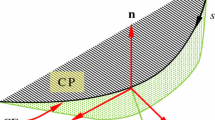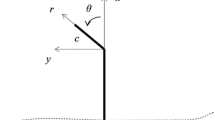Abstract
In order to study the behavior of a crack in a linear-elastic material in plane mixed mode (modes I+II), a specimen's shape and loading have been specially adapted. The specimens are first precracked in mode I and then subjected to monotonic loading until instability is reached by an original device which makes it possible to control the nature of the mixed mode applied and which is adjustable from pure mode I to pure mode II. After the specimens are fractured, the lengths of the initial cracks and the kinking angles were measured in the plane-strain area. Then the stress-intensity factorsK I andK II at the moment when crack instability appeared were calculated. This made it possible to apply two criteria: maximum principal stress and maximum stressintensity factorK *1 at the onset of kinking. From comparing the calculated values with the experimental values we may note that there is good agreement with respect to the crackkinking directions. However, for the limit load values considerable divergences have been recorded which are analyzed.
Similar content being viewed by others
References
Truchon, M. Amestoy, M. and Dang Van, K., “Experimental Study of Crack Growth Under Biaxial Loading,” Advances in Fracture Research 4,ICF 5, Cannes (1980).
Abdallah, M.G., “Review of the State-of-the-Art of Advanced Composites Interlaminar Shear Test Methods,” Proc. 1986 SEM Spring Conf. on Exp. Mech., 301–310 (1986).
Arcan, M. and Banks-Sills, L., “Mode II Fracture Specimen. Photoelastic Analysis and Results,” Proc. 7th Int. Conf. on Exp. Stress Analysis, Technion, Haifa, Israel, 187–201 (Aug. 1982).
Erdogan, F. and Sih, G.C., “On the Crack Extension in Plates Under Plane Loading and Transverse Shear,” J. Basic Eng. (Dec. 1963).
Jones, D.L. and Chisholm, D.B., “An Investigation of the Edge-Sliding Mode in Fracture Mechanics,” Eng. Fracture Mech.,7 (1975).
Royer, J., “Fatigue en mode mixte de l'acier 22M5,” Proc. 10th Can. Cong. of Appl. Mech. (June 1985).
Royer, J., “A Specimen Geometry for Plane Mixed Modes,”Eng. Fract. Mech.,23 (4),763–775 (1986).
Bui, H.D., Mecanique de la Rupture fragile, ed. Masson (1978).
Bilby, B.A., Cardew, G.E. and Howard, J.C., “Stress Intensity Factors at the Tips of Kinked and Forked Cracks,” Fracture,3,ICF4, Waterloo, Canada (1977).
Amestoy, M., Bui, H.D. and Dang Van, K., “Analytic Asymptotic Solution of the Kinked Crack Problem,” Advances in Fracture Research, ICF5, Cannes (1980).
Author information
Authors and Affiliations
Rights and permissions
About this article
Cite this article
Royer, J. Study of pure and mixed-mode fracture of a brittle material. Experimental Mechanics 28, 382–387 (1988). https://doi.org/10.1007/BF02325180
Received:
Revised:
Issue Date:
DOI: https://doi.org/10.1007/BF02325180




